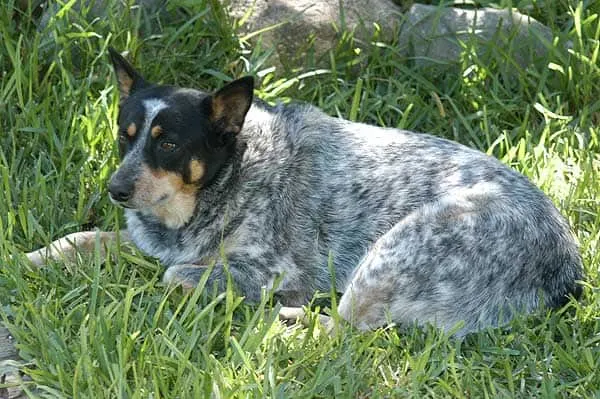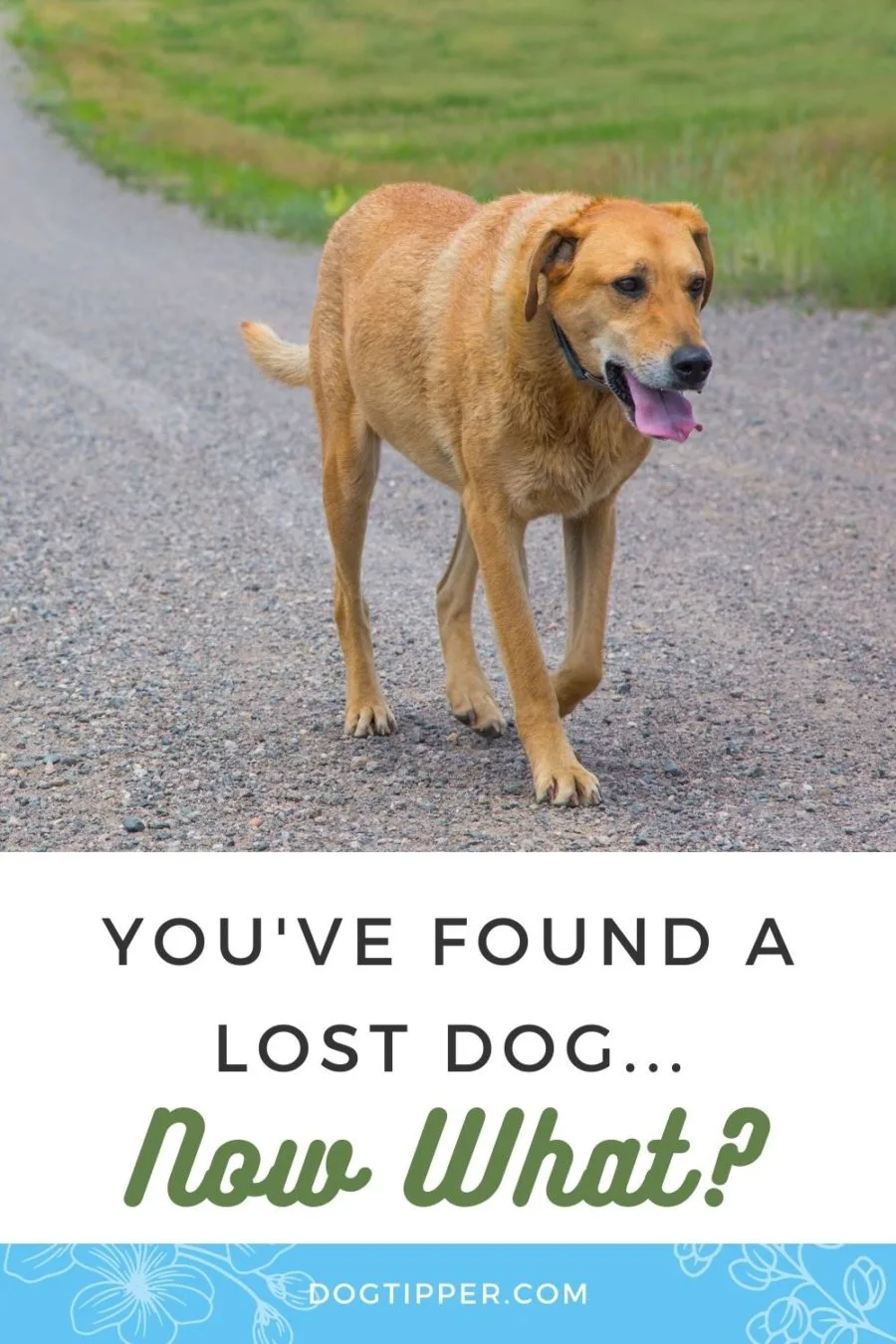You are on a walk and up comes a lost dog. Or you open your door to one day find a dog on your doorstep. What do you do?
We’ve found many dogs through the years, and we’ve got tips on what to do when you’ve found a lost dog to help identify him and get him back to his owners as soon as possible.
When is the most common time to find a lost dog?
The month of July is Lost Pet Prevention Month, an observance created by PetHub. Thanks to the noise of fireworks, more dogs go missing on the Fourth of July weekend than any other time of the year–but we all know that dogs get lost year around.
Similarly, New Year’s Day is also another peak time for finding lost dogs who have run away during the New Year’s Eve fireworks.
If you’ve found a lost dog, there are steps that you can take to make sure the dog gets to safety and that you also remain safe in the process.

Our Own Experience Finding Lost Dogs
Just a few weeks ago, John and I were driving back home from a restaurant dinner. About halfway home, we saw a man and woman on the sidewalk, both looking down a busy street and pointing. Before we got any closer, I had already guessed what they were watching: a lost dog.
Sure enough, a Lab mix was running up and down a busy street, darting on and off the sidewalk, back and forth onto the road.
John and I drove past the dog then I hopped out to sit on the sidewalk with a Styrofoam box of leftovers. What dog could resist a cheese enchilada, right?
Well, apparently this dog. I tried my best lost dog techniques: turning away from the dog, calling the dog with outstretched arms, kneeling on the sidewalk. They were all techniques that have worked numerous times in the past but, this time, the dog was just too excited to slow down and approach me.
Fortunately, a woman soon walked by with her dog on leash–and that was all it took for the dog to overcome his fear and walk on home with her. She said that she recognized the dog as a neighbors’ so this lost dog story has a happy ending.
But not all lost dog stories are so easily resolved.
Before You Spot a Lost Dog
Prepare a lost dog kit to keep in your car. Through the years, we’ve found over 20 lost dogs so we’re prepared with some basic supplies: a slip leash (don’t assume the dog will be wearing a collar), some cat treats or a can of cat food (the scent is strong enough to lure timid dogs), a bottle of water, and, for the times you might need them, heavy gloves.
When You Spot a Lost Dog
- Assess the dog. Look at the dog’s body language. Is he friendly? Frightened? (A great resource for learning body language is the book Canine Body Language: A Photographic Guide Interpreting the Native Language of the Domestic Dog by Brenda Aloff.) Is he hurt or aggressive, both which could lead to a bite? (Remember, if you are bitten by an unknown dog who then turns and runs, you’ll need to receive rabies treatment. If he’s injured or aggressive, call for help first.)
- Assess the situation. Are you able to approach the dog safely without risk to you or the dog from traffic?
- Take a photo of the dog. Before you start calling the dog (and risk him running the other way), take a quick cell phone shot that you can later use to post, in the event you’re not able to successfully catch the dog.
- Consider calling the authorities. If you aren’t comfortable working with the dog, if the traffic is just too heavy, or if you’re just not in a situation where you can transport the dog, call local authorities. A call to the non-emergency police number in most locations can send out non-emergency animal control assistance.
- Plan your actions to lure the dog away from traffic. Where would you like to lure the dog? Make the plan before leaving your car.
- Park your car and, with leash and treats in hand, try calling the dog.
- Kneel. A couple of years ago, we were headed home when we saw a pizza delivery man chasing a Golden Retriever. The dog was darting in and out of traffic. I got out of the car, knelt down, and spread my arms wide then just called the dog over to me. Sometimes being calm and welcoming can lure a dog to you. If the dog’s body language doesn’t lead you to believe he’s aggressive or fearful, this can be a great technique.
- Turn away from the dog. Unless you feel this is a fearful dog who might bite when your back is turned (in which case you want to call 411 instead of handling the dog yourself), turn and slowly begin walking away from the dog to see if he’ll follow.
- Ask the dog if he’d like to ride in the car. Last July 4th, I found a Basset Hound and a Catahoula wandering along the road. I opened the back of my Jeep and asked if they’d like to go for a ride, and in they hopped!
- Check the collar for a tag. With the Basset Hound and Catahoula, I lucked out and, thanks to their collars and ID tags, I had them back to their home 15 minutes later. Many times, I’ve been lucky and have found a current tag on the lost dog and been able to take him directly home. Once, I called the vet listed on the rabies tag and was able to get him home that way.
- No tag? It’s time for a microchip check. Both veterinarian’s offices and shelters will scan lost dogs for a microchip; then contact with the owner can hopefully be made.
When You’re Not Successful in Securing the Lost Dog
Sometimes, in spite of your best efforts, you’re just not going to be successful in obtaining the lost dog. Again, give 411 a call.
Also, make a note of the location where you saw the dog–the street address or intersection, the time, and the direction in which the dog was traveling.
Do a quick drive of the neighborhood and see if you spot a Lost Dog sign. The dog may have been lost for days but may be hanging out in the neighborhood. A call to the owners, even without the dog in hand, will help the owners in their search.
Once you get home, check Craigslist and NextDoor for lost dog notices. Again, a note to the owners of the place and time when their dog was spotted can be essential information. Similarly, a note that a lost dog was spotted at the intersection can be beneficial.
When a Lost Dog Comes to Your Home
Through the years, we’ve also had numerous lost dogs show up at our home, lured either by the scent or sound of our own dogs or by the water in our nearby creek.
In fact, we’ve had so many lost dogs show up at our home–and be picked up by us along the road–that we now have a small fenced dog run just for “visiting” dogs, a place to let them rest safely yet, at the same time, be separated from our own dogs.
Once you’ve separated the dog from your own, provide food and water then, if you haven’t already, check for an ID tag.
When You’ve Got a Lost Dog in Your Possession
OK, you’ve either got a lost dog in the car or a lost dog at your home. You’ve found a lost dog–now what?
As mentioned above, check for an ID tag (which has reunited almost every dog we’ve ever found with their owners) then plan to visit a veterinarian’s office or shelter for a microchip scan. Hopefully the scan will reveal a microchip and contact can be made with the owner to whom it is registered. (Unfortunately, some people move and don’t update the microchip databases. Dogs are also given away or sold without updates so even a chip doesn’t ensure a return.)
If you don’t find a chip or a tag, you’ll next have to make a decision. Do you want to leave the dog with a shelter? The shelter will be the most likely place the owners will look. However, some shelters can only hold dogs a few days.
If you would like to hold the dog yourself, reach out to the area shelter anyway with a description of the dog and a photo. (Unless you’re sure the dog is purebred, don’t make your description breed specific but, instead, describe the size, color and shape of the dog. Leave out some piece of information that only the owner would know–perhaps some unique marking.)
Next, turn to Craigslist and NextDoor to look for Lost Dog notices and to leave your own notice that you’ve found a lost dog.
Again, don’t be breed specific–since the dog may be a mixed breed–unless the dog is clearly a purebred. You don’t want someone to skip over the “Found: Labrador Retriever” when the dog is a Doberman mix, at least in the owner’s eyes. In your notice, again hold back some information that only the owner will know, such as a coat pattern or unique marking or even the gender.
Along with digital outreach, go old school: check the newspaper for “lost dog” notices in the classified ads and consider your own “found dog” ad as well. Finally, post “Found Dog” signs in the area, especially near where the dog was found.
The One Time We Weren’t Able to Locate a Lost Dog’s Owner
Through the years, we’ve been incredibly lucky in reuniting lost dogs and their owners. In only one case were we unable to find the owner of a dog who showed up at our home.
After several weeks of searching, we came to realize that the lost dog was a stray dog (a thought our vet confirmed after x-rays showed a poorly mended broken leg)–and that dog became our sweet Alby.

Pin It to Remember What to Do If You’ve Found a Lost Dog!

- Review: Jimmy BX7 Pro Anti-Mite Vacuum Cleaner - December 16, 2024
- 🎉 GIVEAWAY: Lord of the Pets Portrait of Your Dog! - November 26, 2024
- Review: Lord of the Pets Portraits - November 17, 2024
